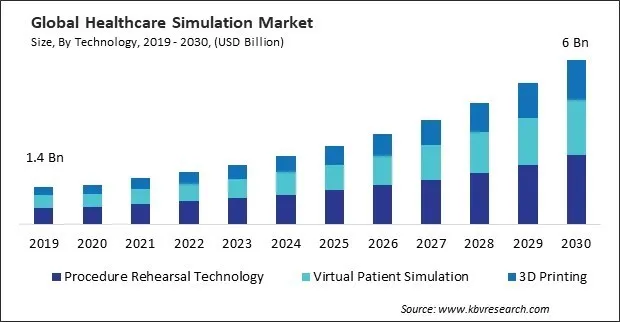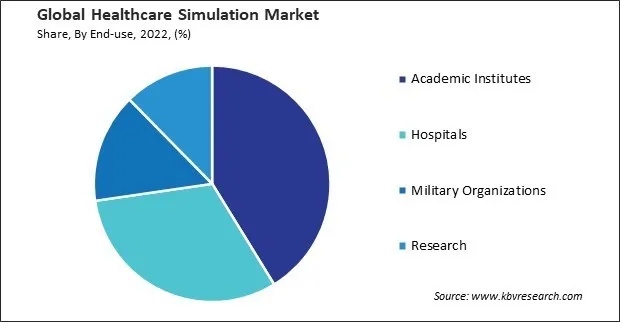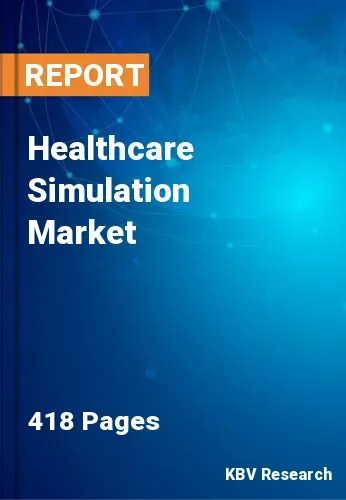“Global Healthcare Simulation Market to reach a market value of USD 6 Billion by 2030 growing at a CAGR of 15.5%”
The Global Healthcare Simulation Market size is expected to reach $6.0 billion by 2030, rising at a market growth of 15.5% CAGR during the forecast period.
Gynecological care often involves collaboration among multidisciplinary teams comprising obstetricians, gynecologists, reproductive endocrinologists, urogynecologists, radiologists, anesthesiologists, nurses, and support staff. Therefore, the gynecology simulators segment captured $54.6 million revenue in the market in 2022. Gynecology simulators support multidisciplinary team training exercises, interdisciplinary simulations, and collaborative learning experiences that simulate real-world clinical environments and promote interprofessional collaboration.

In many healthcare settings, there’s a scarcity of opportunities for students and healthcare professionals to interact with real patients due to various reasons such as privacy concerns, patient preferences, and limited clinical resources. Therefore, the shortage of clinical training opportunities drives the market’s growth.
Additionally, patient safety is paramount in healthcare, and simulation provides a controlled environment where healthcare professionals can learn and practice without putting real patients at risk. This allows learners to make mistakes, learn from them, and refine their skills without adverse consequences to patient safety. Thus, increasing focus on patient safety is propelling the market’s growth.
However, simulation equipment, including manikins, task trainers, virtual reality systems, and simulation software, can be expensive to purchase and maintain. The initial investment required to acquire these technologies can be prohibitive for many healthcare organizations, especially smaller clinics or educational institutions with limited budgets. Hence, high initial investment is impeding the growth of the market.
With restrictions on in-person gatherings and clinical rotations, healthcare education programs have increasingly turned to remote learning solutions, including virtual simulation platforms. Virtual simulation allows learners to engage in hands-on training activities from any location, enabling continuity of education during the pandemic. Thus, the COVID-19 pandemic positively impacted the market.


The interventional/surgical simulators segment is further subdivided into laparoscopic, gynecology, cardiovascular, arthroscopic, spine, and others. In 2022, the laparoscopic surgical simulators segment procured 32.1% revenue share in the market. Laparoscopic surgery requires surgeons to master intricate skills and techniques to manipulate specialized instruments and visualize internal structures using a camera system.
By technology, the market is segmented into procedure rehearsal technology, virtual patient simulation, and 3D printing. In 2022, the procedural rehearsal technology segment recorded 44.1% revenue share in the market. Procedural rehearsal technology allows healthcare professionals to practice and refine their procedural skills in a simulated environment before performing them on real patients.
Based on end-use, the market is categorized into academic institutes, hospitals, military organizations, and research. In 2022, the hospitals segment registered 31.5% revenue share in the market. Hospitals require healthcare professionals to possess various clinical skills to deliver high-quality patient care.

Based on product & services, the market is divided into healthcare anatomical models, web-based simulators, healthcare simulation software, and simulation training services. The healthcare simulation software segment attained 14.7% revenue share in the market in 2022. Healthcare simulation software provides a virtual platform for creating realistic and immersive simulation-based learning environments.
The healthcare anatomical models segment is further divided into patient simulators, task trainers, interventional/surgical simulators, endovascular simulators, ultrasound simulators, dental simulators, and eye simulators. The task trainers segment attained 10.8% revenue share in the market in 2022. Task trainers offer focused and targeted training for specific skills or procedures.
On the basis of type, the patient simulators segment is divided into high fidelity, medium fidelity, and low fidelity. In 2022, the high fidelity segment attained 42.9% revenue share in the market. High-fidelity simulators leverage cutting-edge technology and sophisticated hardware and software components to simulate complex medical scenarios with high fidelity.
Free Valuable Insights: Global Healthcare Simulation Market size to reach USD 6 Billion by 2030
Region-wise, the market is analyzed across North America, Europe, Asia Pacific, and LAMEA. The North America region witnessed 42.6% revenue share in the market in 2022. North America, particularly the United States and Canada, boasts some of the world’s most advanced and well-established healthcare education systems.
| Report Attribute | Details |
|---|---|
| Market size value in 2022 | USD 1.9 Billion |
| Market size forecast in 2030 | USD 6 Billion |
| Base Year | 2022 |
| Historical Period | 2019 to 2021 |
| Forecast Period | 2023 to 2030 |
| Revenue Growth Rate | CAGR of 15.5% from 2023 to 2030 |
| Number of Pages | 418 |
| Number of Tables | 700 |
| Report coverage | Market Trends, Revenue Estimation and Forecast, Segmentation Analysis, Regional and Country Breakdown, Porter’s 5 Forces Analysis, Company Profiling, Companies Strategic Developments, SWOT Analysis, Winning Imperatives |
| Segments covered | Product & Services, Technology, End-use, Region |
| Country scope |
|
| Companies Included | CAE Inc., Laerdal Medical Limited, Gaumard Scientific Company, Inc., Kyoto Kagaku Co., Ltd., Limbs & Things Limited, Mentice AB, Simulab Corporation, Intelligent Ultrasound Group PLC, Surgical Science Sweden AB, Medical-X |
By Technology
By End-use
By Product & Services
By Geography
The Market size is projected to reach USD $6.0 billion by 2030.
Shortage of clinical training opportunities are driving the Market in coming years, however, Limited access to simulation resources restraints the growth of the Market.
CAE Inc., Laerdal Medical Limited, Gaumard Scientific Company, Inc., Kyoto Kagaku Co., Ltd., Limbs & Things Limited, Mentice AB, Simulab Corporation, Intelligent Ultrasound Group PLC, Surgical Science Sweden AB, Medical-X
The Academic Institutes segment is generating highest revenue in the Market by End-use in 2022; thereby, achieving a market value of $2.4 billion by 2030.
The North America region dominated the Market by Region in 2022, and would continue to be a dominant market till 2030; thereby, achieving a market value of $2.4 billion by 2030.
Our team of dedicated experts can provide you with attractive expansion opportunities for your business.

 Drivers
Drivers
 Restraints
Restraints
 Opportunities
Opportunities
 Challenges
Challenges
